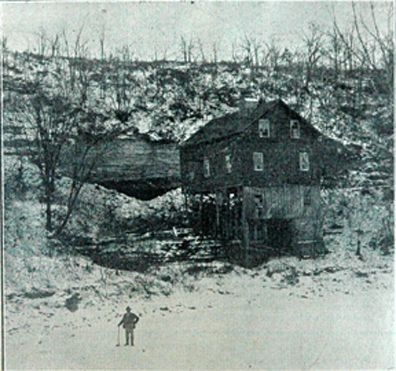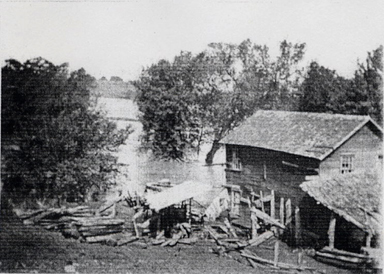|
|
 |
Madison
County, Iowa
|

|
|
 |
EARLY
MADISON COUNTY MILLS (PAGE
2) |
|
|
By H. A. Mueller
This information was taken from the book, The History of Madison County, Iowa, Herman August Mueller, 1915, pages 150–55. — Judy Wight Branson
|
|
BACK
TO PAGE 1
|
|
|
|
Afton Bridge Mill
What is known as the Afton Bridge mill was built in 1850 by
J. T. Bertholf. It was a grist mill. Bertholf sold it to
Joseph Wright, who added to the industry a sawmill. This property was located on the section line between sections 13 and 14, Lincoln Township, and just north of the present Afton bridge. The sawmill was further down the river along a bayou, through which the mill race ran. Mr.
Tomlinson bought it later of Mr. Wright and operated it for some time.
|
|
Andrew Bertholf Mill
Andrew H. Bertholf in 1854 built a sash sawmill, operated by water power, just below the present
Linsey
Bertholf bridge and near the center of section 17, Lincoln Township. This was run a few years; then the machinery was removed in 1866 and installed in the
James
Bertholf mill further down the river.
|
|
Backbone Mill
About the year 1859, John
Harmon built what has since been known as the Backbone mill. It was an “up and down” affair, and got its power from the river by tunneling a passage for the stream through the rock of the “backbone” to the wheel. Harmon sold to
W. L.
Wilkin and R. D. Vermillion in 1867, who put in a grist mill;
G. F.
Kleatsch worked for them. This mill was run for several years by various owners until 1882, when
Henry
Evans bought it and operated it for some time. The old mill has been lying idle the last fifteen years or more. In the meantime part of the structure was torn down, but some of it is still standing.
|

|
|
|
Barker Mill
About 1853, or 1855, Samuel
Barker built a sawmill on Grand River, on section 17,
Grand River Township, which afterwards became known
as Barker ís mill. It was operated about ten
years, part of this time by Dr.
J. H. Mack. It then stood idle until about
1860, when it became practically a ruin. About 1875
George
Everett put up a small building, constructed a wooden
wheel and in this primitive mill ground corn and
chop feed. In 1877,
Evan
Doty and Captain Barker, son of Samuel Barker
, bought the property, put in a thirty-six inch
Leffler turbine wheel and erected a new building.
Here quite a milling business was conducted by the
persons just named until 1889, when
Alvin
Griswold purchased the mill and in 1892 attached a
circular saw and manufactured lumber. This mill was
torn down a few years ago, and was the last water
power mill run in Madison County.
|

|
|
|
Drake Ford Mill
The Brinson mill at Drake Ford was a water power mill, built in 1849, by
David Hagge. He boarded with Absolom Thornburg and took down with the smallpox while building it, giving the disease to all the family, accept one son, George. This was the first circular sawmill in the county and stood east of Drake Ford bridge on section 15 east of the house now owned by
J. E.
Addy in Lincoln Township. Mr. Hagge sold to Craig Gaines and
Mike
Danner in 1851. Later Joseph Brinson, father of
William Brinson, of Winterset, purchased it and operated the mill until the dam washed out.
Brinson then sold the property to John Reed, who rebuilt the mill a short distance above and across Middle River, put in burrs and ground both wheat and corn, besides sawing lumber. The dam washed out in 1864, which induced
Reed to sell the machinery; the building was torn down and moved away.
|
|
Hartman Mill
Hartman & Downs mill, west of Hanley, was begun in the year 1851 as an “up and down” affair, completed in 1853 and operated until some time during the sixties, when Dr.
William Anderson, father of H. P. and E. K.
Anderson, and an old practicing physician, bought, controlled and operated it until about 1869, at which time
Elijah
Collins bought a half interest in the enterprise. During the summer of 1871 the firm of
Anderson& Collins rebuilt and improved the mill and was ready for operations in 1872, when
M. I.
Bean and E. Collins managed the business. In 1873, M. I.
Bean purchased Collins’s interset and continued to run the mill until 1876, when high water took out the dam. The property was then sold to
R. A.
Howard and his father, who built a new dam, but the floods again came and washed out the improvements, so the mill was abandoned in 1877. The site of the
Hartman & Downs mill is a short distance west from Clanton Creek, and east of Bridgeport schoolhouse.
|
|
Hiatt & Brown Mill
The Hiatt & Brown mill in Walnut Township, was constructed in the fall of 1852 by
Aaron
Hiatt and B. F. Brown. It was a sawmill, operated by waterpower, and stood on Clanton Creek, in section 11, about a half mile southeast of East Peru. The mill was completed in the summer of 1853 and was put together by
F. S. J. Garroutte, of Winterset, later of Adel. All was in running order by the spring of 1854, when the wheel was found deficient, so a Johnston wheel was put in. This mill was owned and operated by
Hiatt & Brown until about 1856, when Aaron Hiatt sold his interest to
Elijah Hiatt, late of Truro, and father of Surveyor E. E.
Hiatt. About 1860
Hiatt sold his interest to John Steel and later bought B. F.
Brown’s interest, which he sold to Benjamin
Reed about the close of the war. About the year 1868 the mill was washed away by high waters.
|
|
Hockenberry Mill
The Hockenberry mill was an “up and down” waterpower sawmill and was built in 1855, in section 14, Webster Township, by
M. C.
Hockenberry and Paul Denning, but was not completed until 1856. The builders operated it up to the beginning of the Civil war, when
Hockenberry sold his interest to Paul Denning, who in turn sold it to
Edward M. Roseman in 1870. Mr. Roseman operated the mill a few years and then lost it by floods.
|
|
James Bertholf Mill
There was an “up and down” sawmill built in 1866 by
James Bertholf. It stood on the west side of Middle River, on the section line of sections 16 and 21, Lincoln Township. The machinery was brought from
Andrew
Bertholf ’s mill further up the river. Joseph Brinson bought the property in 1869, operated it a few years and then sold it to
Linsey Macumber, who ran it for three years and sold to
Alex
Macumber in 1872, who continued to operate it one year. The building washed away in the floods of 1876 while owned by
D. Philbrick.
|
|
|
Kidd Brothers Mill
An item appears in the November 16,
1871 edition of the Winterset Madisonian stating
that "The Kidd Brothers are doing a good business at
their steam sawmill,
near the Middle River Bridge, in this
township (Crawford), all bills of lumber filled on short
notice." (Information transcribed
by County Coordinator - KT) |
|
| Lick
Skillet Mill
An item appears in the August 24,
1871 edition of the Winterset Madisonian stating
that the steam sawmill known as the "Lick
Skillet Mill" located in Grand River Township
had suspended operation pending a move to Afton. No
further details are provided. (Information
transcribed by County Coordinator - KT) |
|
Phipps Mill
What was known as the Phipps mill was built in 1866 by
James
Phipps , further up Clanton Creek, on section 27, on land now owned by
S. T. Johnston. The mill was completed in 1867 and subsequently
Phipps sold half of his interest to Isaac Allen and the balance to
William
Allcock later. About 1873 the new firm sold to R. M. J.
Collins, who was proprietor of the mill until 1876, when the high waters destroyed it.
|
|
Webster Mill
Charles Friend began the construction of a sawmill in 1854,
M. C.
Hockenberry doing the construction work. It was completed by
B. F.
McAfferty and Fred Mason, who had it in operation in 1856. They ran the mill about three years, when
Otho
Davis got possession, and added a set of burrs and ground corn. Then in turn, as millers, came a Mr.
Hoadley, Asbury Evans (August, 1871), Carl Sampson, George
McVey, Rufus Ullery, Mr. Hohn, and finally Mr.
Rogges. No sawing had been done for thirty years, and probably no grinding for fifteen years. About 1903, or 1904, the building was still standing on the bank of Middle River, south of Webster, and about a quarter of a mile west of the public road running south of town. It was at that time decaying rapidly and the river had washed around the south end of the dam, leaving the mill on dry land. The machinery, however, was still in the building and all it needed, so it seemed, was repairing. This was the beginning of the last chapter in the history of the old Webster
mill.
|
|
|
|
|
|
Maintained by
the County Coordinator
|
| |
This
page was created on July 23, 2004.
This page was last updated Thursday, 13-Apr-2017 13:16:41 CDT
.
|
|